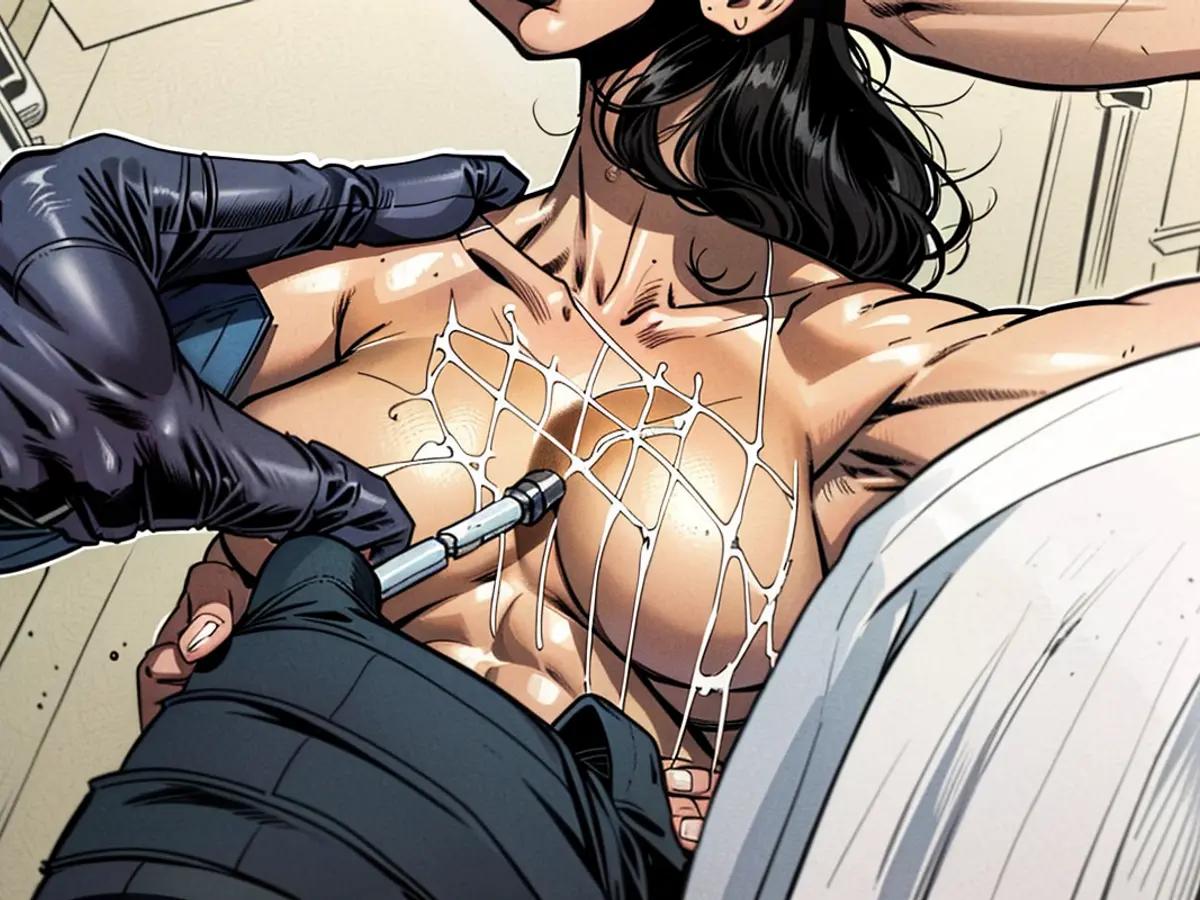How much sweat is normal? - Do you sweat a lot? This may indicate an illness
People sweat. Sometimes due to exertion or heat, other times due to excitement. It's a normal thing, yet it's unsettling. One looks, when someone stands before you with sweat stains on their clothing or extends a sweaty hand. "The heat" or "I had to run here" is used as an excuse. Fortunately, such situations are rare. Unfortunately, however, for nearly one million people in this country. They sweat persistently. Regardless of outdoor temperature, exertion, and emotions, sweat pours uncontrollably from them, most often on the armpits, feet, or hands. Every day. They suffer from Hyperhidrosis.
There are two types of pathological sweating. In primary Hyperhidrosis, the cause cannot be precisely determined. In secondary Hyperhidrosis, excessive sweating is a symptom, for example, of an illness such as the flu or a hormonal change during menopause. The third form is bromhidrosis: In this case, the sweat smells unusually strongly.
The Boundary Between Sweating and Hyperhidrosis
When does normal sweating end and Hyperhidrosis begin? It's not a question of sweat volume. A healthy person can lose several liters of sweat per day in hot weather or during strenuous activity. Hyperhidrosis is, rather, a question of timing. According to medical guidelines, "sweating occurs temperature-independently, unpredictably, and not willfully controllable." In medicine, the condition is divided into three severity grades. In the most severe grade, the sweat patches have a diameter of more than 20 centimeters, and the "sweat drips off." The medical language is quite straightforward here.
For the affected individuals, it is primarily a social challenge. Hyperhidrosis affects interactions with others and, in particular, partners. The incessant sweating irritates the skin under the armpits and causes redness, pimples up to feelings of foreign bodies. Some have trouble keeping their glasses from slipping off their sweaty hands or their touchscreens no longer reacting to their wet fingers. At their feet, the permanent sweat weakens the horny layer. Some have to buy oversized shoes to accommodate the additional space with absorbent inserts or paper. Others keep a large supply of spare underwear in the office. If the skin is constantly excessively moist, it leads to subsequent conditions: bacterial skin infections, foot fungus, wart formation.
The Causes? Still a Puzzle.
For those who are affected, they unfortunately often experience exclusion and early on discover that household remedies are not sufficient for sweating control. The symptoms are not due to an excess or large number of sweat glands, but rather from an overactivity of the nerves that regulate them. The exact cause of primary hyperhidrosis, which cannot be attributed to organic, hormonal, or psychological factors, is still not fully understood. Sometimes medical causes such as a malfunction of the thyroid gland or hormonal imbalances are behind the disease, sometimes psychological causes such as anxiety or stress are the trigger. Many universities offer special consultations for the affected. The German Hyperhidrosis Center is located in Munich. There are only estimates regarding the number of affected individuals, which range from one to five percent of the German population.
From Salves to Nerve Dissection: The Treatments Are Diverse
Medicinal Antiperspirants
Most antiperspirants contain aluminum salts in various concentrations. The aluminum salt penetrates the pores, binds to keratin, and seals or narrows the sweat glands. The higher the aluminum salt concentration, the deeper it penetrates into the skin. The solution can be applied to the axillary, hand, and foot areas. Medically approved antiperspirants with high aluminum salt concentrations are available for purchase in pharmacies, but they can cause skin irritation and allergic reactions. They are only suitable for mild hyperhidrosis.
Botox Injection Treatment
The injection of the neurotoxin Botulinum Toxin under the skin paralyzes the muscles and, in turn, the sweat glands. This method is also effective for hands and feet. Botox injections for axillary sweating are now covered by health insurance with a valid indication. Each treatment costs between 500 and 1000 euros and must be repeated every six months.
Cream with Glycopyrroniumbromid, GPB
At least for axillary hyperhidrosis, there has been a simple relief for a year: a cream. The effect of the prescription-only Axhidrox cream from the German pharmaceutical company Dr. Wolff is based on glycopyrroniumbromide, or GPB. The medication inhibits the signal transfer between nerve and sweat gland. GPB belongs to the widely used anticholinergics in medicine, which have previously been prescribed as tablets for uncontrollable sweating. The side effects of the tablets can be severe: dry mouth, fatigue, visual disturbances up to nausea. Packaged in a salve, the medication only works where it is applied. According to research studies, the cream is said to act quickly and the side effects are only "mild to moderate." Dry mouth occurs much less frequently compared to the tablet.
### Another Method: Iontophoresis
Another method, presumably free of side effects, is the so-called Iontophoresis. In this electric current therapy, hands or feet are held in a water bath or a sponge is placed under the arms. Through the water, a weak electrical current is conducted. The mechanism of action is unknown. It is believed that the sweating threshold, which triggers sweating, is increased by electrical stimulation. A dermatologist can prescribe this device for self-treatment at home. However, the therapy is laborious, as it must be done daily. The treated skin areas dry out as a result.
Sweat Gland Suction
This method is suitable for people who sweat profusely in the armpits. The area is locally anesthetized. First, fluid is pumped into the affected area. The doctor then uses a metal rod to loosen the tissue. The corresponding tissue is then sucked out, including the sweat glands. Approximately 80% of the glands are removed in this way. Sweating is still possible, but it can be easily controlled with deodorant. Sweating stops immediately after the procedure, as sweat glands cannot regenerate. Sweating in other areas also decreases. This sweat gland removal is only practiced in a few clinics and is usually not covered by health insurance.
Outdated but Effective: Sweat Gland Removal
The surgical removal of sweat glands under the armpits is an outdated method, but it was usually covered by health insurance. In this procedure, the entire sweat gland area under the armpits is removed. Only a 10 to 20 centimeter long scar remains, which often leads to skin tension and pain in the shoulder area. Approximately 90% of the sweat glands are removed in this way, but the procedure is more extensive and the scar can be a hindrance.
Effective but not risk-free: Sympathectomy
In a sympathectomy, a part of the sympathetic nerve is removed through an endoscopic procedure on the right and left spinal column. The sympathetic nerve is part of the autonomic nervous system. From it, small nerve fibers go to the skin. They regulate sweating. To turn off sweating on the hand, a half centimeter is removed between the third and fourth ribs. The nerve fibers that lead to the hands are thereby paralyzed. To stop sweating on the forehead, the nerve is cut between the first and second ribs. A side effect of this operation is compensatory sweating: Sweating from the hand or forehead is redirected to the back or abdomen. For the affected persons, this is usually much less bothersome.
The sympathetic nerve section carries numerous bodily and to some extent serious psychological risks. It should be the last resort if all other therapies fail.
Although the smell of sweat can be unpleasant, for people with Hyperhidrosis, the persistent sweat stains and odor are a daily struggle. Despite using medicinal antiperspirants or Botox injections, the sweat stains on their clothing remain an issue, often leading to the use of oversized shoes or multiple changes of underwear throughout the day. Unfortunately, the exact cause of primary Hyperhidrosis is still not fully understood, making it a challenge to develop effective long-term solutions. The sweating, regardless of the cause, can lead to various skin conditions such as bacterial skin infections and foot fungus.









